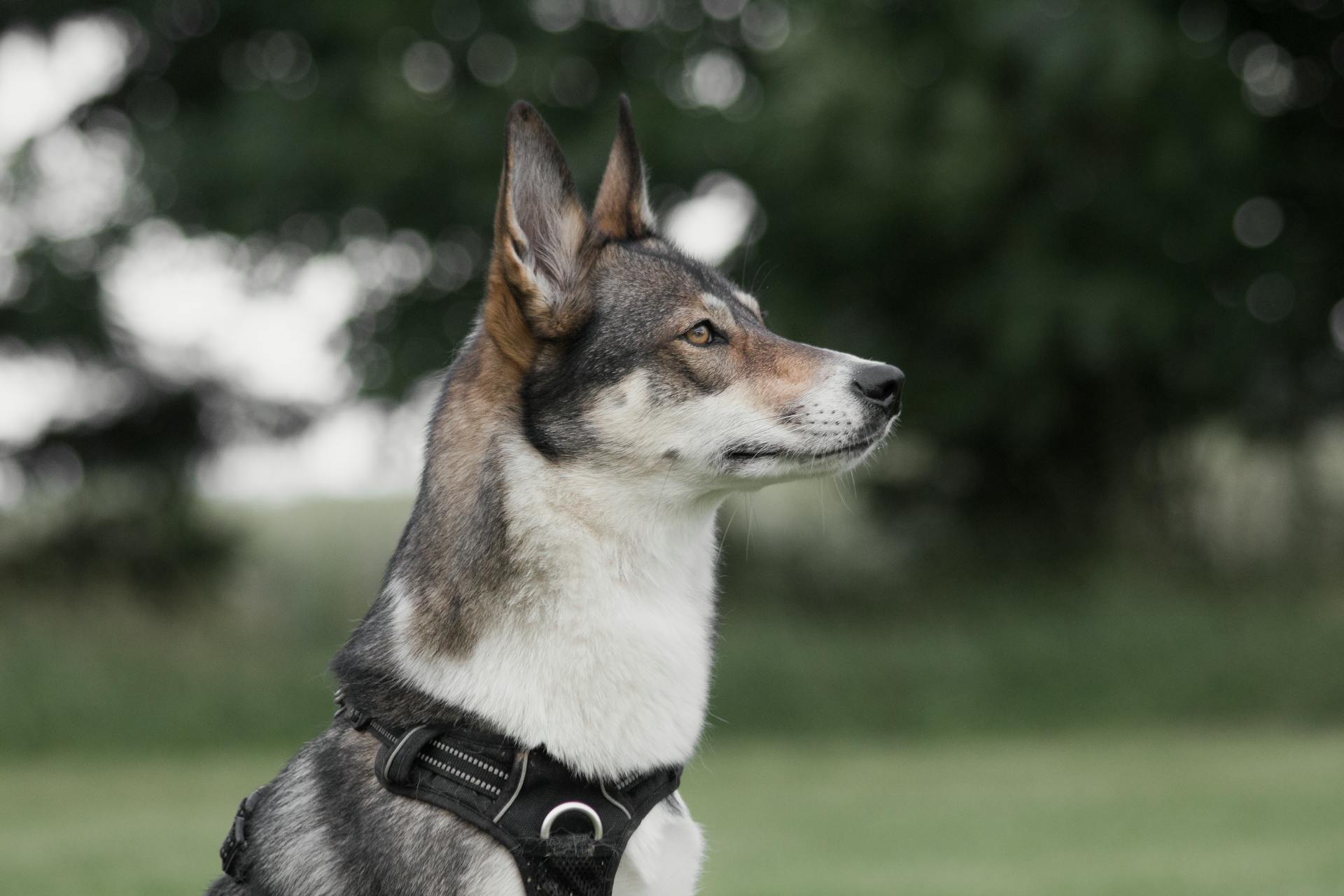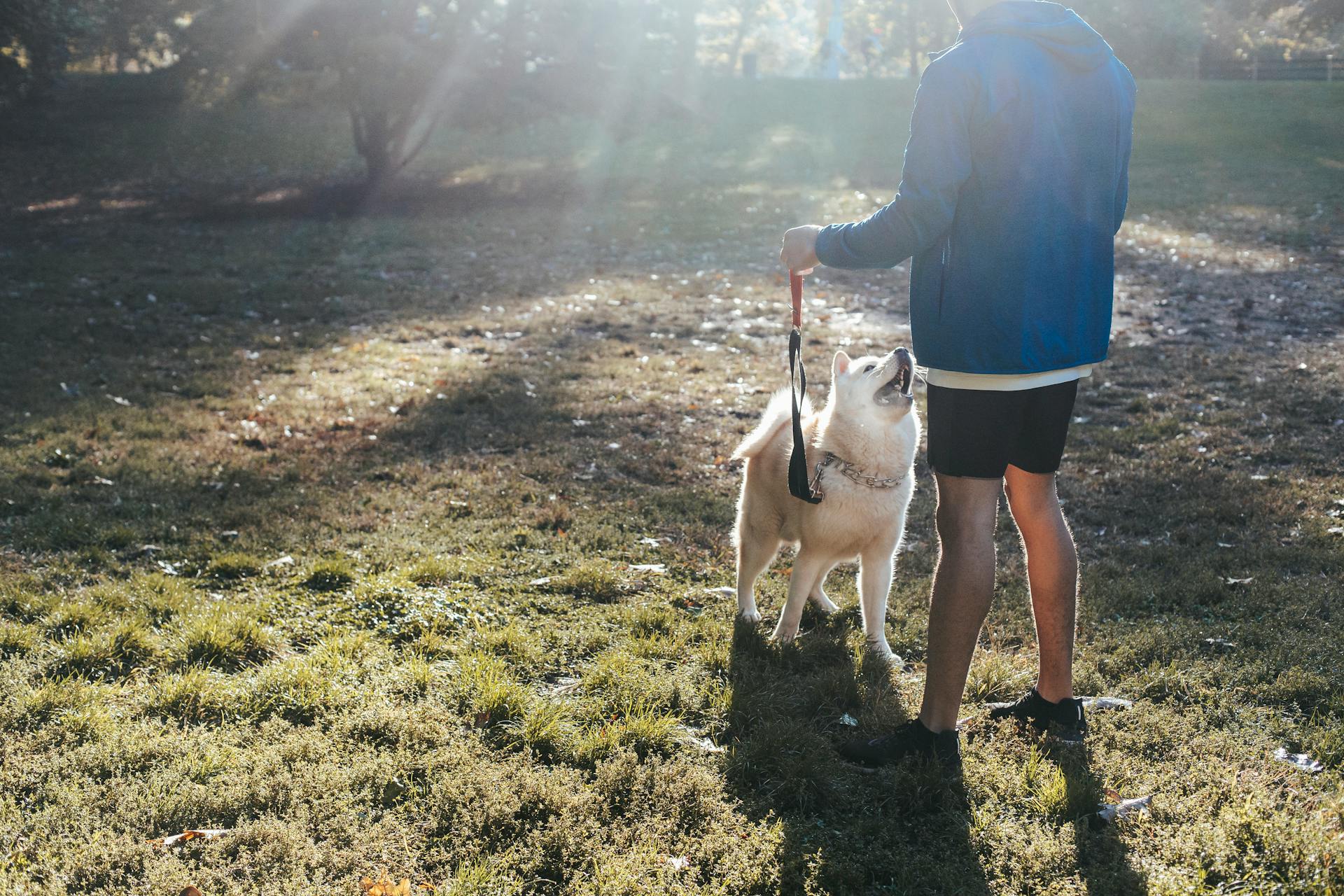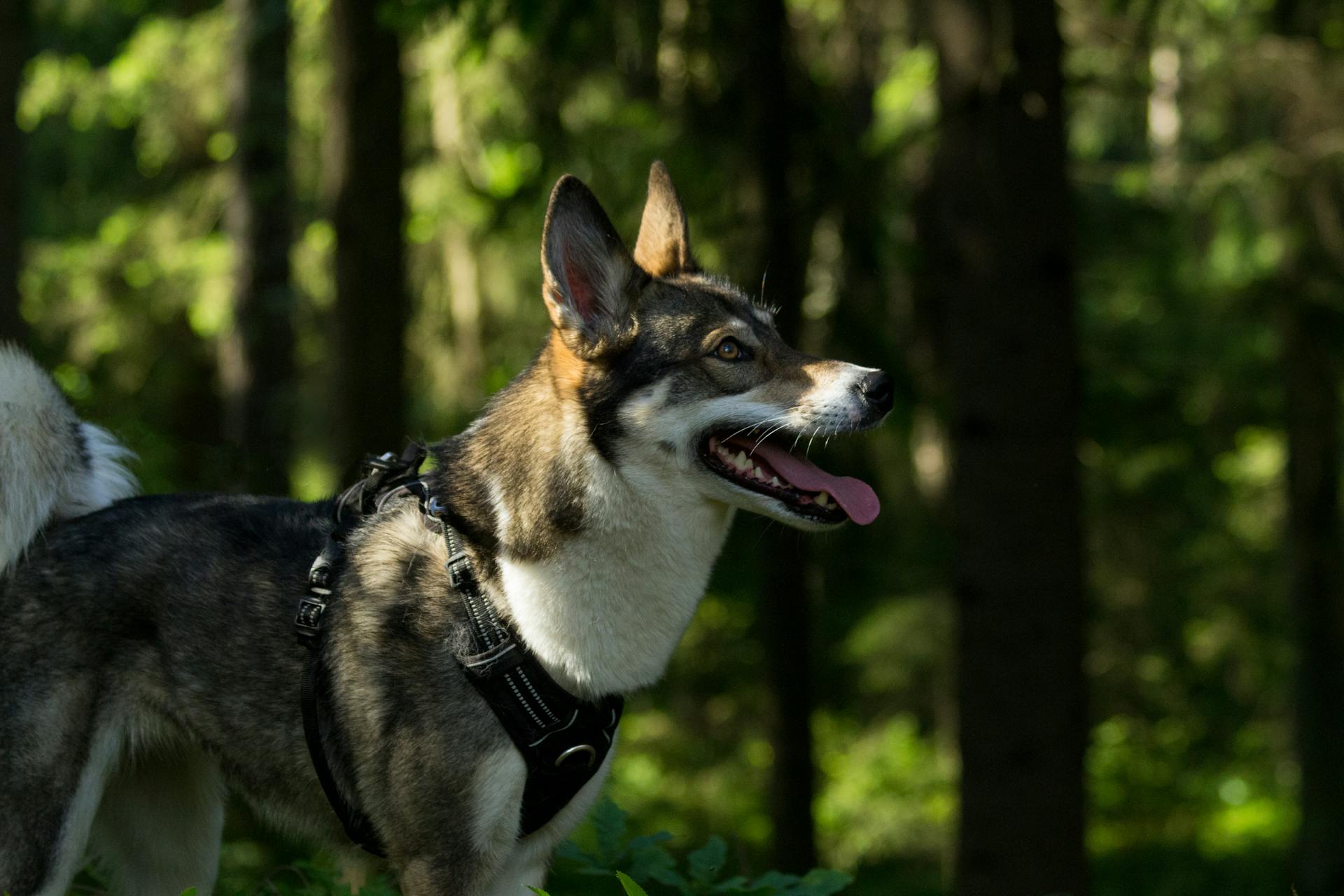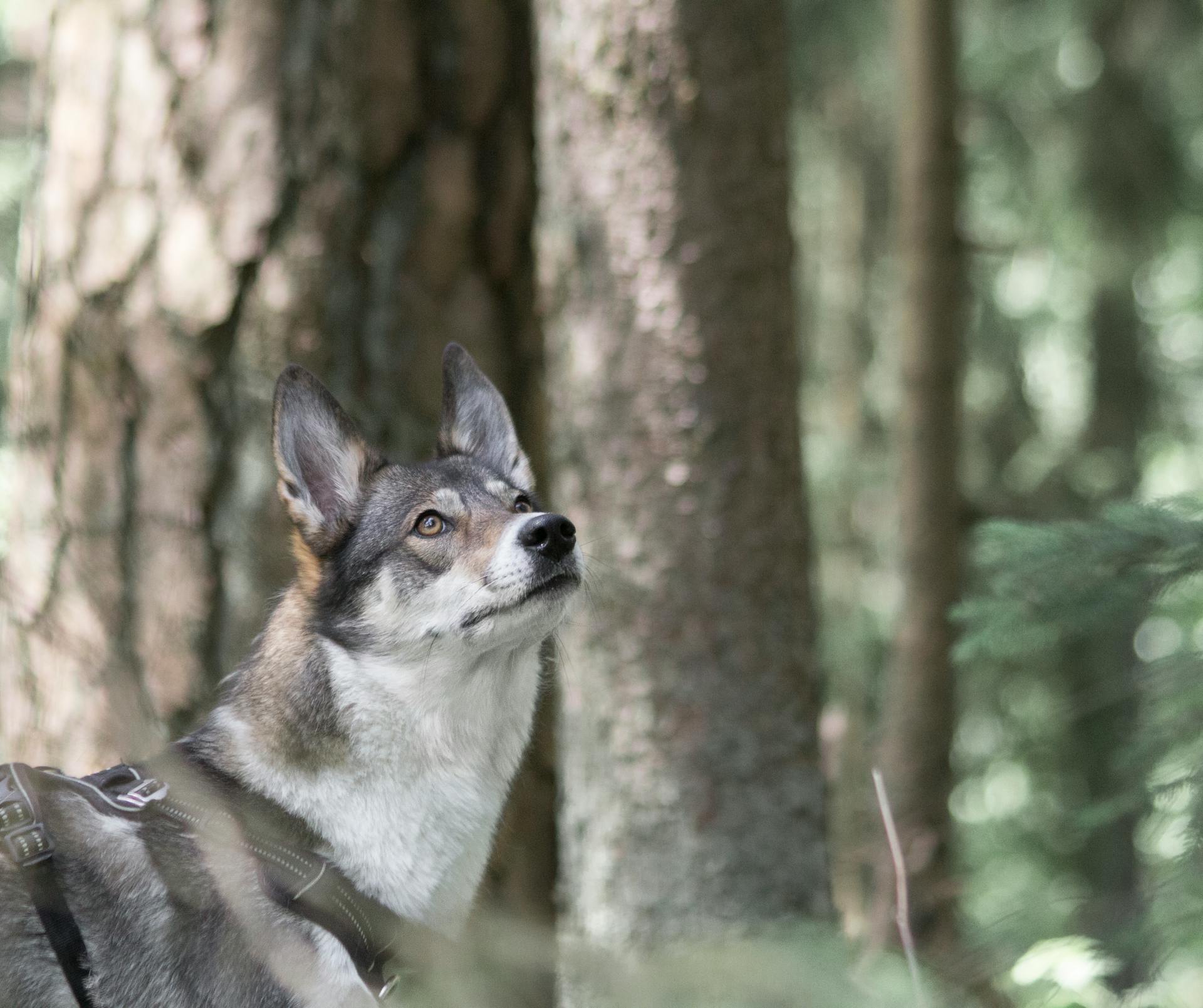
The West Siberian Laika is an ancient breed that originated in Russia, where it was bred to hunt small game in the harsh Siberian wilderness.
This breed is known for its incredible tracking ability, which allows it to follow scents that are hours old.
West Siberian Laikas are medium-sized dogs with a muscular build and a thick coat that protects them from extreme cold.
They come in a variety of colors, including black, brown, and white, and typically weigh between 45-60 pounds.
As a relatively low-maintenance breed, West Siberian Laikas require regular exercise but don't need a lot of grooming.
Their intelligence and independence make them a great fit for experienced dog owners who are willing to provide the necessary training and attention.
Here's an interesting read: West Highland White Terrier
About West Siberian Laika
The West Siberian Laika is a loyal breed that thrives on family bonding. They have a strong loyalty to their family unit.
Their calm and even temperament makes them suitable for families without small children. However, it's essential to remember that proper exercise is crucial to prevent aggressive or destructive behavior.
These dogs are naturally inclined to be watchdogs, always keeping a watchful eye on their surroundings. They can make great companions for active families who appreciate the outdoors.
With proper training and socialization, West Siberian Laikas can get along well with other animals. They have high exercise needs that must be met to keep them happy and healthy.
Physical Characteristics
The West Siberian Laika is a striking breed with a robust build and well-muscled limbs, giving them a powerful and sturdy appearance. Their strong and pointed face, combined with a full, deep, and broad muzzle, makes them look like a true companion for hunting.
Their coat is a testament to their adaptability to the harsh Siberian environment, consisting of a dense double coat with harsh straight guard hairs and a thick, soft undercoat. This keeps them insulated in severe weather and comes in shades of wolf gray, pale red, or white.
Here are some key physical characteristics to look out for in a West Siberian Laika puppy:
- Robust build
- Well-muscled limbs
- Powerful and sturdy appearance
- Strong and pointed face
- Full, deep, and broad muzzle
- Dense double coat with harsh straight guard hairs and a thick, soft undercoat
Their body shape is almost square, with a slightly longer length than height, giving them a lean and athletic appearance. Their brown eyes are deep-set, and their ears stand erect on top of their head, adding to their wolf-like appearance.
Information and Pictures
Physical characteristics can be observed and measured to better understand the subject.
The subject's height is approximately 5 feet 9 inches tall, which is average for an adult.
Their weight is around 150 pounds, a healthy weight range for an adult.
Their hair color is dark brown, a common color found in many people.
Their eyes are a bright blue, a rare but striking color.
Their skin tone is fair, a result of limited exposure to the sun.
Their body shape is slender, a characteristic often associated with a low body mass index.
You might like: English Springer Spaniel Tricolor
Physical Characteristics and Coat Quality
The West Siberian Laika is a striking breed with a wolf-like appearance and a body that's almost square. Their robust build and well-muscled limbs give them a powerful and sturdy appearance.
Their coat is a testament to their adaptability to the harsh Siberian environment. A dense double coat keeps them insulated in severe weather, with harsh straight guard hairs and a thick, soft undercoat.
Here are the key characteristics of a West Siberian Laika's coat:
- Consists of a dense double coat
- Has harsh straight guard hairs and a thick, soft undercoat
- Keeps them insulated in severe weather
- Sports shades of wolf gray, pale red, or white
- Can include a variety of shades and patterns of patches
Their strong and pointed face, with a full, deep, and broad muzzle that tapers slightly toward the nose, completes their wolf-like appearance.
Character and Temperament
West Siberian Laika puppies are naturally protective of their people and property, often warning away intruders with their barking.
They can be quite territorial and may show aggression towards other dogs, especially those of the same sex, if they feel the need to defend their space.
If you're considering a West Siberian Laika as a pet, it's essential to provide them with plenty of exercise and mental stimulation to keep them occupied and prevent hyperactivity.
Their loyalty and affection towards their owners are unmatched, often forming strong emotional bonds through shared experiences in the great outdoors.
With proper care and attention, West Siberian Laikas can make excellent companions and family pets, leveraging their intelligence and versatility to thrive in various environments.
For more insights, see: West Siberian Laika Dog
Personality and Temperament
The West Siberian Laika is a breed that's not for the faint of heart. They're naturally protective of their people and property, often barking at intruders to warn them away.
Their loyalty to their family is unwavering, forming strong bonds with their owners through shared experiences. They're highly territorial and may show aggression towards other dogs, especially those of the same sex.
A West Siberian Laika's behavior can be complex and multifaceted, much like the wild lands they hail from. They're not just a hunting machine, but a breed that's deeply connected to their environment.
In the right situation, a West Siberian Laika can make an excellent companion and family pet. Their loyalty and protective nature make them a great addition to a family that's active and outdoorsy.
They're not suited for every household, however. If you're an inexperienced owner, you may want to consider a different breed.
Intriguing read: Bernese Mountain Dog Protective
Independence and Training
The West Siberian Laika's independence is one of its most notable characteristics. They are a working dog by nature and can be very protective of their people and property.
Their strong will can make training a challenge, especially if they don't feel like listening to their trainer. In fact, they may even ignore their trainer if a hunting opportunity arises.
However, with the right approach, they are intelligent dogs that are keen to please. Treats can be a great motivator, and consistent training methods can help even the most wilful West Siberian Laika.
Proper early socialization is crucial in managing their strong prey drive and potential aggression towards other animals. Animals that have been raised together should have few issues getting along.
Their independence can also lead to destructive behaviors when left alone or confined. A West Siberian Laika kept in a garden without an outlet for their abundant energy is a recipe for disaster.
With patience, kindness, and consistent training, you can help your West Siberian Laika become a well-behaved and loyal companion.
Trainability and Hunting
Training a West Siberian Laika puppy requires patience and consistency, as they can be quite independent and stubborn at times. This breed is known to ignore commands if they don't feel like following them.
However, they are highly intelligent and love to please, especially when treats are involved. Experienced trainers who use diverse methods can get great results with this breed.
The key to successful training is to be consistent and creative in your approach. West Siberian Laikas are naturally inclined to listen to their trainers when they find a method that works for them.
Their intelligence and strong prey drive make them well-suited for hunting, and they excel in tracking and holding game. They can cover up to 80 kilometers during hunting trips, making them perfect for long-distance hunts.
Here are some key traits of West Siberian Laikas in hunting situations:
- Small game
- Large game
- Birds
- Bears
Their adaptability and strong prey drive also mean they can be prone to chasing pets or other small animals, so early socialization is crucial.
Trainability
The West Siberian Laika's trainability is a unique challenge. They can be very hard to ignore when a hunting opportunity arises, making it difficult to resist the urge to give chase.
This independent streak can make training a bit of a struggle. However, they are an intelligent dog that is keen to please, particularly if treats are involved.
Experienced trainers who are consistent and use diverse training methods can get good results with even the most willful West Siberian Laika.
Hunting Dog Skills
The West Siberian Laika is renowned for its intelligence, emotional depth, and versatility in hunting. These dogs are capable of hunting small game, large game, birds, and even bears.
Their impressive stamina allows them to cover up to 80 kilometers during hunting trips, making them perfectly suited for hunting. Their high energy levels and strong prey drive also make them effective hunters.
West Siberian Laikas excel in tracking and holding game using their acute senses of sight, hearing, and smell. They employ a hunting strategy that involves silent stalking until cornering their quarry, then vocalizing to alert the hunter.
In team hunts, coordination is key, and West Siberian Laikas coordinate their movements with other dogs to effectively encircle the prey. They may also use barking as a strategy to keep the prey in place.
Here are the skills that make West Siberian Laikas formidable hunting companions:
- They use their acute senses to silently track prey
- They prove their worth as silent hunters
- They have excellent tracking and stalking skills
- They work well with other dogs
Their strong prey drive might lead them to view pets such as neighbors' cats as potential prey. This adaptability shines through in various hunting scenarios, and they've proven their versatility across different hunting situations.
Health and Reproduction
The West Siberian Laika is known for its robust health, rarely suffering from frequent illnesses. They can live long lives, reaching 14 to 17 years of age.
Two congenital conditions have been reported in the breed, which are inherited diseases and should not be bred from. These conditions include hernias, which can range from small to significantly large.
Despite their overall vigor, West Siberian Laikas can be prone to certain health problems, such as hip and elbow dysplasia, as well as eye disorders including retinal dysplasia and cataracts.
Worth a look: Bernese Mountain Dog Hip Dysplasia
Health and Reproduction
The West Siberian Laika is known for its robust health, rarely suffering from frequent illnesses. Many even live long lives, reaching 14 to 17 years of age.
These dogs are less prone to health issues due to their lack of inbreeding and their history of being bred for hunting purposes. This has resulted in a breed that is hardy and resilient.

The average litter size for a West Siberian Laika typically ranges from 6 to 10 puppies. Female West Siberian Laikas exhibit a unique behavior of digging their own whelping dens and raising their puppies without human assistance.
Despite their overall vigor, West Siberian Laikas can be prone to certain health problems such as hip and elbow dysplasia, as well as eye disorders including retinal dysplasia and cataracts.
Selective Breeding
Selective breeding played a crucial role in shaping the West Siberian Laika breed. Regulated breeding of West Siberian Laikas led to the establishment of four recognized Laika breeds in Russia, including the West Siberian Laika itself.
Selective breeding focused on hunting abilities, adhering to a breed standard, and only allowed dogs demonstrating exceptional skills to breed. This rigorous focus led to the emergence of a versatile hunting breed.
The breed standard was the guiding force behind selective breeding, ensuring that only the best traits were passed down to future generations. Through this process, the West Siberian Laika developed into a robust and adaptable breed.
Here are the four recognized Laika breeds established through selective breeding:
- Karelo-Finnish Laika
- Russ-European Laika
- West Siberian Laika
- East Siberian Laika
Exercise and Care
The West Siberian Laika is a high-energy breed that requires regular exercise to stay happy and healthy. They need daily long brisk walks and the opportunity to roam in a large fenced yard.
Exercise is crucial for burning off energy, and activities like running, playing, and hunting are perfect for this breed. With strong hunting instincts, they'll chase after small prey if given the chance, so it's essential to keep them on a leash when out and about.
Providing regular and frequent interaction with their owner is also vital to maintain their obedience and happiness. This can be achieved by incorporating them into daily routines and tasks, reducing the need for separate activity sessions.
Recommended read: What Do Puppys Need
Exercise and Activity
The West Siberian Laika is a high-energy breed that requires regular exercise to stay happy and healthy. They need daily long brisk walks and the opportunity to roam in a large fenced yard.
Exercise is essential to prevent dog aggression, and providing them with ample physical outlets can help mitigate the risk. Regular and frequent interaction with their owner is also crucial to maintain their obedience and happiness.
Allowing your West Siberian Laika to burn off energy at any opportunity is key, whether that's on hikes, jogs, or hunting trips. This will help them stay happy and focused.
If you do decide to let your dog off the lead, be aware that they have very strong hunting instincts and may chase after small prey. So, it's essential to keep a close eye on them in these situations.
Providing your West Siberian Laika with a substantial amount of exercise, including daily long brisk walks and the opportunity to roam, can help reduce the need for separate activity sessions.
Grooming
Grooming is essential for the West Siberian Laika, as it sheds its fur profusely and requires daily brushing outdoors to reduce shedding within the home.
Compatibility and Origins
The West Siberian Laika is a breed with a rich history and unique characteristics. They originated from the indigenous Mansi and Khanty peoples of Ural and West Siberia, who used them as hunting dogs to survive in the challenging Siberian environment.
Their development was temporarily disrupted by World War II, but by 1946, systematic breeding recommenced, laying the groundwork for the breed we know today. The breed gained official international recognition on January 1, 1996, with its acceptance by the United Kennel Club.
West Siberian Laikas can coexist peacefully with other pets if they are properly trained and socialized, especially if raised together from a young age.
Aboriginal Dogs and Early Development
The West Siberian Laika's roots are deeply connected to the indigenous Mansi and Khanty peoples of Ural and West Siberia. They used the ancestors of the modern West Siberian Laika as hunting dogs, harnessing their abilities to survive and thrive in the challenging Siberian environment.
The breed's development was temporarily disrupted by World War II, but by 1946, systematic breeding recommenced, laying the groundwork for the breed we know today. This means that the modern West Siberian Laika has a rich history dating back to the late 19th century, when Russian experts began to study and classify various Laika breeds based on their uses and association with different native groups.
Historically, WSLs were known as Mansi Laika and Khanty Laika, named after the indigenous peoples who utilized these dogs for hunting and as draft animals. They were a vital part of these communities, helping them to survive and thrive in the harsh Siberian environment.
The modern West Siberian Laika breed is the result of the merging of two distinct aboriginal dog types, creating a resilient breed capable of coping with the harsh Siberian environment. This unique blend of characteristics makes the West Siberian Laika an exceptional hunting companion.
Animal and Pet Compatibility
West Siberian Laikas can coexist peacefully with other pets if they are properly trained and socialized from a young age. They can learn to accept cats and other small pets.
Their strong prey drive might lead them to view pets such as neighbors' cats as potential prey. However, with the correct training, they can live in harmony with other domestic animals within the same household.
West Siberian Laikas show a greater tolerance towards other dogs compared to their Eastern counterpart, making them suitable for households with multiple dogs. They can learn to live with other dogs, but proper training and socialization are still essential.
A different take: Average Lifespan of a Pembroke Welsh Corgi
Featured Images: pexels.com


